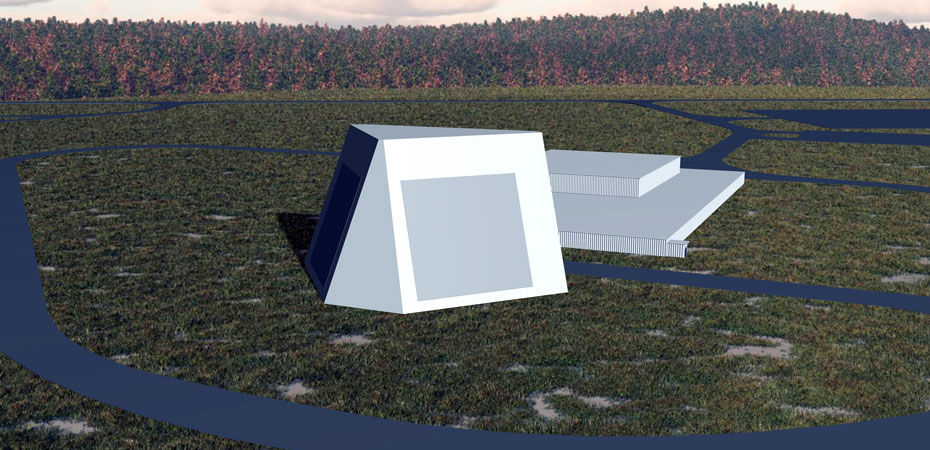
The Long Range Discrimination Radar (LRDR) is a long-range, midcourse tracking radar designed to provide continuous coverage and improved discrimination capabilities to defend the U.S. homeland. The radar is intended to support the layered U.S. BMD defense system to defend against threats emanating from the Pacific and will provide more deployment flexibility for the Sea-Based X-band radar.1 It is undergoing testing at Clear Air Force Station, Alaska, and is planned to be operational in 2021.2
LRDR History
In March 2014, the U.S. Missile Defense Agency released a Request For Information (RFI) about a potential radar that “will provide the Warfighter with a persistent midcourse Ballistic Missile Defense System (BMDS) discrimination capability contributing to the MDA mission of developing and deploying a layered BMDS to defend the United States from ballistic missile attacks of all ranges in all phases of flight.” The LRDR would provide midcourse tracking to increase effectiveness of homeland GMD infrastructure and Pacific missile defense architecture.
In 2015, the Obama administration awarded a contract to build the new LRDR at Clear Air Force Station in Alaska.
Following a pandemic-related work stoppage, MDA completed installation of LRDR’s antenna arrays in November 2020.3 LRDR tracking tests have been pushed back to late FY 2022.4 The USAF is expected to take ownership of the Alaska LRDR in late FY 2023.5
Specifications
The LRDR consists of a solid-state, active electronically-scanned antenna.6 It operates in the S-band frequency and uses gallium nitride (GaN) technology that allows for continuous coverage, even when it is undergoing maintenance. The radar is expected to improve the U.S. GMD system by providing enhanced capability to distinguish lethal objects from debris and decoys.7
The LRDR may also support U.S. Air Force space operations, including its situational awareness mission.8
SPY-7 Variant
The AN/SPY-7 is a modern radar designed for use with the Aegis Combat System. It is derived from the LRDR and uses common equipment and software.9 The radar is has been selected for procurement by the United States, Canada, Japan, and Spain.10
The United States plans to deploy a scaled-down version of the radar in and for the defense of Hawaii, designated the Homeland Defense Radar-Hawaii (HDR-H).11 Canada plans to use equip its future Canadian Surface Combatant with the SPY-7. Spain will equip its future F-110 frigate with the SPY-7. Japan planned to equip its two Aegis Ashore systems with the SPY-7, but those programs were cancelled. Japan will still procure the SPY-7, likely to equip current or future Aegis ships.12
Footnotes
- “Missile Defense Agency Fiscal Year (FY) 2015 Budget Estimates,” Missile Defense Agency, February 20, 2014, https://www.mda.mil/global/documents/pdf/Budget_Overview.pdf.
- Jen Judson, “MDA says Alaska-based missile defense radar will be operational in 2021,” Defense News, March 2, 2021, https://www.defensenews.com/pentagon/2021/03/02/mda-says-alaska-based-missile-defense-radar-will-be-operational-in-2021/.
- U.S. Congress, Senate, Subcommittee on Strategic Forces, Missile defense strategy, policies, and programs in review of the Defense Authorization Request for fiscal year 2022 and the Future Years Defense Program, (Testimony of Jon A. Hill) 117th Cong., 2nd sess., (June 9, 2021), https://www.armed-services.senate.gov/imo/media/doc/Hill%20Written%20Statement%20to%20SASC%206-09.pdf.
- Jen Judson, “Yearlong delay hits operational test of Alaska-based missile defense radar,” Defense News, April 30, 2021, https://www.defensenews.com/air/2021/04/30/alaska-based-missile-defense-radar-operational-test-delayed-a-year/.
- Ibid.
- “Lockheed Martin to Head Team in Development of LRDR Radar for Missile Defense Agency,” CompoundSemi Online, October 27, 2015, http://www.compoundsemi.com/lockheed-martin-to-head-team-in-development-of-lrdr-radar-for-missile-defense-agency/.
- Jen Judson, “Lockheed Wins $784M Long-Range Radar Contract,” Defense News, October 22, 2015, http://www.defensenews.com/story/defense/air-space/air-force/2015/10/22/lockheed-wins-784m-long-range-radar-contract/74405952/.
- Mike Gruss, “Lockheed Martin Lands Missile Defense Radar Contract,” Space News, October 22, 2015, http://spacenews.com/lockheed-martin-lands-missile-defense-radar-contract/.
- U.S. Missile Defense Agency, “The SPY-7 Hybrid Defense Security Cooperation Project with Japan Completes Initial Engineering Demonstration of Capability,” press release, February 25, 2021, https://www.mda.mil/news/21news0004.html.
- Lockheed Martin, “Why SPY-7 Is the World’s Most Versatile Radar,” https://www.lockheedmartin.com/en-ca/features/why-spy-7-is-the-world-s-most-versatile-radar.html.
- Jen Judson, “Support to pursue Hawaii-based missile defense radar continues after DoD drops funding,” Defense News, August 7, 2020, https://www.defensenews.com/digital-show-dailies/smd/2020/08/07/support-to-pursue-hawaii-based-missile-defense-radar-continues-after-dod-drops-funding/.
- Japan Times, “Japan to use radar intended for land on new Aegis ships,” June 29, 2021, https://www.japantimes.co.jp/news/2021/06/29/national/radar-aegis-ships/.